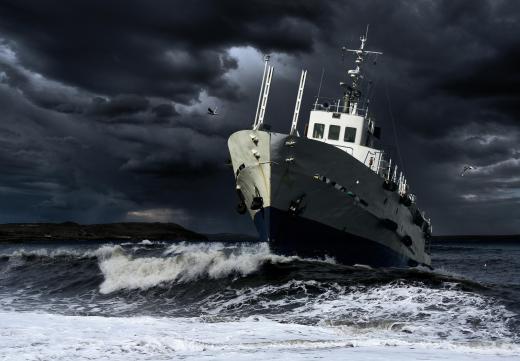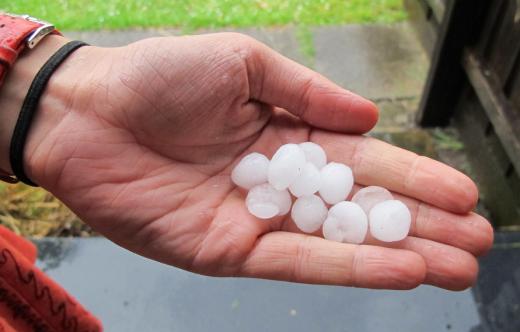What is a Squall?
 Mary McMahon
Mary McMahon
A squall is a rapid increase in wind speed within a short period of time that may last for only a brief burst of a minute or so before dissipating. Squalls can create hazardous weather conditions and are of special concern for mariners and aviators, who can be in danger if they encounter one without adequate preparation. For the etymologically inclined, this word appears to derive from an Old Norse term meaning “to squeal,” a meaning people can see referenced in another common use of this word, to describe sudden loud cries from a baby.
The causes of these sudden bursts of wind can vary, depending on the region and weather situation, and they tend to be especially common around bodies of water, because air moving over water can change quickly in behavior. Typically, one appears along with a burst of rain, snow, or hail. In lake effect squalls, seen when air moves over a lake and dumps snow or rain on the other side, the wind occurs as warm and cold air meet, leading to an increase in moisture over the lake and sudden precipitation at the other side.

Wind speeds can increase dramatically in a squall, and this may be very dangerous. For sailors, the wind can damage sails or even capsize a boat if it is forceful enough. It may also cause large waves to develop, swamping a watercraft and putting it at risk of sinking. This type of weather is a common and well known hazard on many inland bodies of water, like the Great Lakes in the United States and Canada. High winds can be dangerous for aircraft as well, leading to turbulence and potentially causing pilots to lose control of their planes.

A squall line, a related weather term, is a line of small but highly potent thunderstorms. As these move over the landscape, they will release bursts of high wind and wet weather. Such storm systems are sometimes precursors to a larger storm, including meteorological systems like hurricanes. They have distinctively shaped clouds, making it easy for people to identify them in the distance. Mariners who spot a line of storms may seek shelter to protect their boats in advance of the bad weather.

After the sudden burst of bad temper on the weather's part, the sun may come out. It is not uncommon to see rainbows after such storms, and people may notice phenomena like half a structure being drenched in rain while the other half stays dry and sunny. These small, compact weather systems can pack a punch, and are usually gone very quickly.
AS FEATURED ON:
AS FEATURED ON:
















Discussion Comments
Quick changes in air pressure can make for some weird weather. There have been times I have been working outside in the summer and can feel the sudden drop in temperature. Usually this is a warning that some strange weather is about to happen pretty quickly.
One time I didn't even have time to gather up my tools and get inside before the wind picked up and blew like crazy. Even though it didn't last very long, I was kind of scared because I didn't know what was going on. I think this would be really scary if you were out on the water when something like this happened, especially if you had no warning it was coming.
@Mykol -- Even though it is very common for squalls to be close to water, it isn't necessarily so. It sounds like you were in the middle of a squall!
I had something similar happen to me. I felt like we were having a tornado because the wind was so strong. After the brief storm, everything was peaceful, the sun was shining and there was the most beautiful rainbow I had ever seen.
I think it was worth the few minutes of wind and rain just to see the rainbow. I was able to take some great pictures of the rainbow that I still have today. With the sun shining and the rainbow against the background of the mountains, it makes a stunning picture.
Does a squall always happen near a body of water?
When we were hiking in the mountains, something like a squall came up. The weather was fine when we headed out, but within a short time the wind started blowing hard and it even hailed on us. The only good thing was this didn't last very long. Once we got back to camp, everything was dry and it was like nothing had even happened there.
We have a cabin at a small lake in Minnesota, and one year I was caught out in the middle of the lake when a squall came up. It came up so fast I had no time to try to get back to shore.
All I could do was wait it out and hope the wind wouldn't tip the boat over. With the strong wind, came pouring rain. I was just glad it was not a very big lake, as I had no idea how far away I would end up.
After just a few minutes, the squall was over and I was on the other side of the lake. I was scared and soaking wet, but I was OK. Within a few more minutes the water was just as calm as could be and the sun was shining!
@StarJo – Their appearance varies. Sometimes, funnel clouds do develop from squall lines, but not always.
I have seen squall lines that looked like the edge of a giant flying saucer. The clouds were dark blue and gray, and they appeared very ominous. Let's just say that it made me seek shelter.
I often see squall lines while I'm vacationing at the ocean. A very dark blue line of clouds runs across the horizon over the water, and it hangs very low. I have seen waterspouts develop out of these, but they are far enough out on the water that they don't make it to land.
If I see one in the distance, I bring a squall jacket with me onto the beach. It is water resistant and blocks the wind very well, so I won't get hammered with sand and water while trying to make it back to my hotel if the squall does make landfall.
What do squall line clouds look like? Do they resemble funnel clouds, or is it more of a straight line?
I live in tornado alley, so I am very familiar with squalls. The most alarming thing about them is the sudden howling of the wind around the cracks in the windows.
They come from out of nowhere! There have been times when I have been indoors for awhile and I suddenly heard the most eerie and forceful wind whipping around the house.
More often than not, this is followed by hail. I see the white balls bouncing off the ground, and I get very nervous. These often precede tornadoes.
Of course, this isn't always the case with squalls. Even the ones that produce small hail don't necessarily produce a tornado every time. They are severe enough to warrant severe thunderstorm warnings, though.
I was very surprised when my father-in-law told me that squalls can capsize boats on the Great Lakes. While he was in the service, he was out on a boat when a squall hit one of these lakes, and it flipped right over.
I never thought that wind could cause waves to become this large on a lake, but the Great Lakes are so deep and wide that they behave more like the ocean. Being out on one during a squall is extremely dangerous.
Post your comments